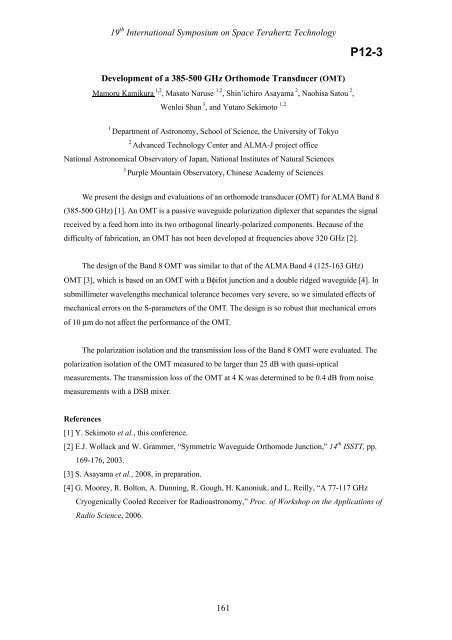Program and Abstract Book - SRON
Program and Abstract Book - SRON
Program and Abstract Book - SRON
Create successful ePaper yourself
Turn your PDF publications into a flip-book with our unique Google optimized e-Paper software.
19 th International Symposium on Space Terahertz Technology<br />
P12-3<br />
Development of a 385-500 GHz Orthomode Transducer (OMT)<br />
Mamoru Kamikura 1,2 , Masato Naruse 1,2 , Shin’ichiro Asayama 2 , Naohisa Satou 2 ,<br />
Wenlei Shan 3 , <strong>and</strong> Yutaro Sekimoto 1,2<br />
1<br />
Department of Astronomy, School of Science, the University of Tokyo<br />
2<br />
Advanced Technology Center <strong>and</strong> ALMA-J project office<br />
National Astronomical Observatory of Japan, National Institutes of Natural Sciences<br />
3<br />
Purple Mountain Observatory, Chinese Academy of Sciences<br />
We present the design <strong>and</strong> evaluations of an orthomode transducer (OMT) for ALMA B<strong>and</strong> 8<br />
(385-500 GHz) [1]. An OMT is a passive waveguide polarization diplexer that separates the signal<br />
received by a feed horn into its two orthogonal linearly-polarized components. Because of the<br />
difficulty of fabrication, an OMT has not been developed at frequencies above 320 GHz [2].<br />
The design of the B<strong>and</strong> 8 OMT was similar to that of the ALMA B<strong>and</strong> 4 (125-163 GHz)<br />
OMT [3], which is based on an OMT with a Bφifot junction <strong>and</strong> a double ridged waveguide [4]. In<br />
submillimeter wavelengths mechanical tolerance becomes very severe, so we simulated effects of<br />
mechanical errors on the S-parameters of the OMT. The design is so robust that mechanical errors<br />
of 10 μm do not affect the performance of the OMT.<br />
The polarization isolation <strong>and</strong> the transmission loss of the B<strong>and</strong> 8 OMT were evaluated. The<br />
polarization isolation of the OMT measured to be larger than 25 dB with quasi-optical<br />
measurements. The transmission loss of the OMT at 4 K was determined to be 0.4 dB from noise<br />
measurements with a DSB mixer.<br />
References<br />
[1] Y. Sekimoto et al., this conference.<br />
[2] E.J. Wollack <strong>and</strong> W. Grammer, “Symmetric Waveguide Orthomode Junction,” 14 th ISSTT, pp.<br />
169-176, 2003.<br />
[3] S. Asayama et al., 2008, in preparation.<br />
[4] G. Moorey, R. Bolton, A. Dunning, R. Gough, H. Kanoniuk, <strong>and</strong> L. Reilly, “A 77-117 GHz<br />
Cryogenically Cooled Receiver for Radioastronomy,” Proc. of Workshop on the Applications of<br />
Radio Science, 2006.<br />
161
















